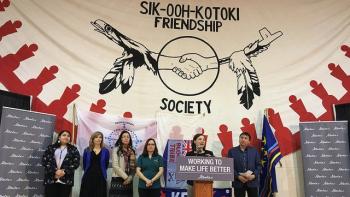By Andrea Smith
Windspeaker Contributor
The Kainai Nation (Blood Tribe) and the province of Alberta announced a new partnership Feb 2. Together, they will work with The Rockies Institute to create a response plan for climate change. The focus of the plan will be “adaptation,” and the project will roll out over the next two years.
“As Minister of Environments and Parks, I inherited a monitoring and science division that has great scientists, and amazing data, and we use both to inform evidence-based ways on how we’re going to move forward in our relationships with our environment,” said Minister Shannon Phillips, just before announcing the official partnership plan.
“But traditional ecological knowledge, traditional wisdom, coming from Indigenous communities, has to be woven into how we understand the science and our relationship to the environment,” she said.
The details of the plan have not yet been completely hashed out, according to Phillips, however the work has partially already begun.
A climate change coordinator was hired last fall by the Blood Tribe; a position made possible by the nearly quarter-million dollar ($230,00 to be exact) grant awarded by the province to Kainai.
So far, the climate change coordinator’s role has been primarily in educating members of the First Nation, as well as gathering the voices of youth, and creating plans for what will come next.
The grant also helps The Rockies Institute create what they refer to as “resilience building activities”, which includes conducting a vulnerability assessment for the Nation, creating an adaptation plan with Kainai, and facilitating a youth climate change art project there. The institute is a charitable organization dedicated to this kind of work. Their website lists their Number One project currently as “Building Climate Resilience and Adaptation in Indigenous and Rural Communities.”
“This grant is funded by Alberta’s climate leadership plans, helping Blood Tribe prepare for future climate change effects, while also informing our own government policies and respectful integration of traditional ecological knowledge,” Phillips added.
Much of the funding comes from the carbon tax being reinvested into community causes, said Phillips, adding that climate adaptation isn’t just about being environmentally friendly, and reducing greenhouse gas emissions, but that it also includes addressing how to respond to issues that are coming up now or may come up in the future, due to climate change. This includes how to better construct our lives around some of those issues, even in terms of building, such as with roadways and bridges.
With regard to the Blood Tribe specifically, this is one the largest First Nations in Canada. Many of the community members own large areas of land which they use for farming and ranching. Droughts from the previous summers affected their businesses drastically.
“What are our most significant environmental concerns? It’s similar to all of southern Alberta. The main environmental concern would be water…. The droughts, and the floods that have been happening more frequently and severely than in the past. We’ve got a huge irrigation project and three of our borders are on rivers,” said Diandra Bruised Head, the recently-appointed climate change coordinator for Blood Tribe.
“We depend on the water a lot for our economy, and in our daily lives… some of the members have wells they get their water from. Access to healthy water… that’s the biggest issue,” she said.
Bruised Head also spoke about the impact of the fire that raged through Waterton National Park last summer. Fires are a huge concern for her nation now, and the effects of that previous fire are still being felt.
That specific severe weather situation—thought to be caused by climate change—brought forward key issues which will be included in the forth coming Kainai adaptation strategy, like access to emergency services, how to deal with air quality issues when they happen, and what to do with the grasslands that were burned.
The Blood Tribe and the Rockies Institute will do the work in creating these plans, while in consultation with the Alberta government as they go along.
“We are very happy to be able to build on what we started over a year ago thanks to investments from the Alberta government. This will help our community develop a much-needed climate adaptation plan as well as inspire youth and Elders to reconnect in new ways while learning about climate change. We look forward to this learning journey between Blackfoot traditional knowledge and western science,” said Roy Fox, Kainai chief.
Minister Phillips said more announcements regarding environmental initiatives in Indigenous communities will be made Monday.

